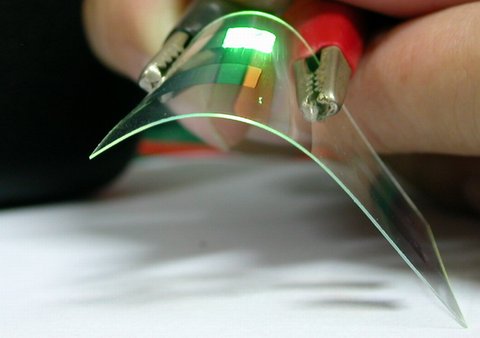
You may have heard that OLED is the TV technology of the future. OLED TVs are starting to become available, and they promise to be cheap, incredibly thin, and even flexible. We’ve talked about 4K TVs, which can be made using OLED or LED technology – but what is OLED, and how does this compare to today’s LED TVs?
Let’s start with how TVs create the picture we watch. First, LED TV’s name is a bit misleading. The picture is actually created using a Liquid Crystal Display, or LCD, (like on a cheap digital wrist watch) with LED lights lighting it from behind. The LCD makes a grid of shutters that allow colour filtered light to shine through (or not shine through). They are called “LED TVs” because LED lights replaced fluorescent lights that used to back light “LCD TVs”. This made TVs thinner and cheaper to make.
Now lets look at OLED – Organic Light Emitting Diode. LEDs and OLEDs are semiconductors that emit light when powered. Here the word organic doesn’t mean its natural and living free  range, but rather a scientific term for an insulator that becomes a semiconductor when a charge is applied. OLEDs make their own light, so they don’t need any back light. OLEDs can be manufactured on thin backplane that can even be flexible. So, which technology is better?
range, but rather a scientific term for an insulator that becomes a semiconductor when a charge is applied. OLEDs make their own light, so they don’t need any back light. OLEDs can be manufactured on thin backplane that can even be flexible. So, which technology is better?
Colour: Advantage OLED TV
Since OLEDs make their own light and can be controlled individually, they have a potential for better colour accuracy. LED TVs need to rely on special technologies and colour filters to make a great picture, but they still fall short of OLED TVs.
Black Level: Advantage OLED TV
One of the main short comings of LED TVs is black levels – the best they can do is a very dark grey. This is due to the shared backlight. Even with high-end LED TVs with hundreds of LED lights behind the TV screen, each light covers thousands of pixels. Its hard to go to black in an area when there are other areas that need light to shine though. Since OLEDs make their own light, each pixel can basically be whatever intensity is required.
Brightness: Advantage LED TV
The other side of the coin is brightness. In scenarios like outdoor TVs or digital signs, TV makers can put whatever light they need to make the back light bright enough. That said, in most home viewing situations including bright rooms, OLED TVs should be bright enough.
Viewing Angle: Advantage OLED TV
The technology that LED TVs use limits the optimal viewing angle. On a LED TV, the optimal viewing is from the centre to about 45 degrees to either side. If you’re looking at it from the side at 45 degrees or more, the picture quality will degrade. OLED TV pictures will not degrade with viewing angle – you will get the same picture quality until you are essentially looking at the side of the TV.
Refresh Rate: Advantage OLED TV
Although this is less noticeable in current LCD LED TVs, LCDs take a millisecond or more to turn on and off. This may sound quick, but our eye catches it as motion blur. This can be noticeable when the picture is changing quickly like in an action movie or hockey game. OLEDs can do this in around 0.01 ms, and our eyes can’t notice that!
Price: Advantage LED TV (today)
Like any technology it takes a while to get manufacturing issues sorted out and costs down. Since OLED TV technology is new, this hasn’t happened yet. That said, if you have deep pockets, current OLED TVs have picture quality that can’t be found in LED TVs at any price. For those of us with more modest budgets, we’ll have to wait a bit longer though.
The really incredible thing about this is that even with the current crop of great LED TVs available at affordable prices, TVs are only going to get better! As 4K UHDTV come into the mainstream, they will be followed by more and more OLED TV options. Deciding on gear like TVs is a balance between the fit for function and budget, but like we do with our clients, choose the TV that fits your needs and timeline. With technology, there is always something better coming, but the right fit will meet your needs for a long time.
